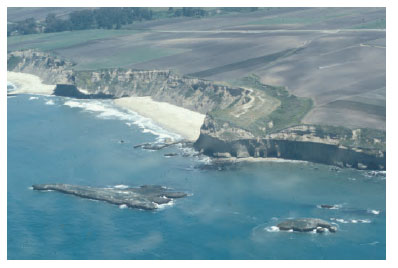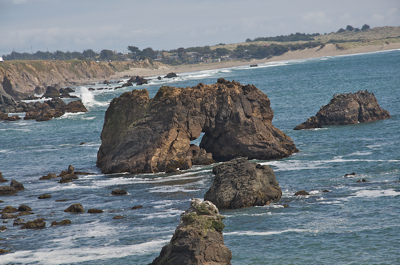Erosional Coastal LandformsSome of the most spectacular scenery is found along coastlines and produced by the effects of wave erosion. Wave erosion undercuts steep shorelines creating coastal cliffs. A sea cliff is a vertical precipice created by waves crashing directly on a steeply inclined slope. Hydraulic action, abrasion, and chemical solution all work to cut a notch at the high water level near the base of the cliff. Constant undercutting and erosion causes the cliffs to retreat landward.
Figure 21.16 Sea cliffs with rocky headlands, sea caves, stacks and a pocket beach San Mateo County, California. Source:USGS Professional Paper 1693 Sea caves form along lines of weakness in cohesive but well-jointed bedrock. Sea caves are prominent headlands where wave refraction attacks the shore.
Figure 21.17 Sea arch and stacks along California coast. Source: Michael Ritter A sea arch forms when sea caves merge from opposite sides of a headland. If the arch collapses, a pillar of rock remains behind as a sea stack.
Figure 21.18 Development of a wave cut notch. (Source: Wikipedia) Seaward of the retreating cliffs, wave erosion forms a broad erosional platform called a wave-cut bench or wave-cut platform. After the constant grinding and battering, eroded material is transported to adjacent bays to become beaches or seaward coming to rest as a wave-built terrace. If tectonic forces raise the bench above the water level a marine terrace forms. Some shorelines have several marine terraces creating during various episodes of uplift.
|


